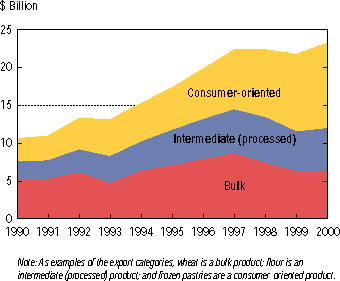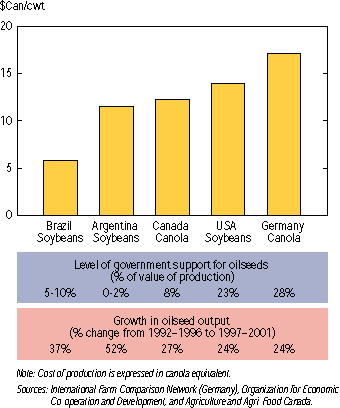

Print ready copy in PDF format
Competition and Subsidies in Global Markets
The Government of Canada and the provincial and territorial governments are working with the industry and interested Canadians to develop an agricultural policy for the 21st century. The objective is for Canada to be the world leader in food safety, innovation and environmentally-responsible production. This proposed policy direction recognizes the increased challenges that Canadian producers face as they work to adapt to rapid advances in technology and compete against other countries in an increasingly complex global food market.
The following is one of a series of three background briefs on key challenges that need to be addressed in building a stronger agriculture and agri-food sector in Canada:
- The effects of competition and subsidies in global markets;
- Rising consumer demands for food safety, enhanced environmental stewardship and other quality attributes; and
- The importance of skills and knowledge in an era of advancing science and technology.
Opportuntity for growth in world markets | Challenge of increased competition in world markets | Support programs - some drawbacks | Summary
Opportunity for growth in world markets
Trade is critical to Canada's agri-food sector
Canada is a major agricultural producer with a relatively small population. As a result, we export almost half of our farm products, either directly as primary products or indirectly as value-added processed products. Because of the amount of exports, the success of the agri-food sector depends, in large part, on international markets. But competition in these markets is increasing, which has implications for both the sector and Canadian agricultural policy.
In recent years, Canada's agri-food exports increased rapidly. Between 1990 and 2000, they more than doubled, to $23.4 billion a year. Much of the growth occurred in value-added products, which now account for the majority of agri-food exports.
In the future, international markets will continue to be a source of growth both for high-value products and bulk commodities.
Given the importance of international markets to the future growth of the sector, Canada is actively pursuing a multi-pronged trade policy to improve market access and to level the playing field through the current round of World Trade Organization (WTO) negotiations and through regional agreements like the Free Trade Area of the Americas (FTAA). At the WTO, Canada is pushing for real and substantial market access improvements, the elimination of export subsidies and the maximum possible reduction of trade-distorting domestic support.
Total Canadian Agri-Food Exports

Challenge of increased competition in world markets
Increased international competition drives prices down
Technological change, ranging from increased mechanization of agriculture to advances in biotechnology, has been affecting agriculture for decades. This change has increased the efficiency of world agricultural production and has allowed both existing farm operations to improve their yields and new operations to begin production in areas previously thought to be unsuitable for farming. As a result, technological change has increased productivity, reduced production costs, and increased total production.
One of the most significant effects of technological change and increased competition is the long-term decline in most commodity prices. For example, in the grains and oilseeds sector, the price of wheat (price of #1 CWRS adjusted for inflation) has fallen at a significant pace over several decades as indicated in the following graph.
Wheat price adjusted for inflation

In recent years market forces have pushed prices down
More recently, the decline in wheat prices has also been driven by some short-term factors including the economic collapse in Southeast Asia and the former Soviet states which reduced world demand over the period 1995-2000. In addition, policy reforms in China have made it largely self-sufficient in grains, reversing its role as a major importer of grains.
International comparison of the costs of production for oilseeds, 1999

Competition increasing from low-cost countries, with little government support
Increasing world supply has added to the pressure on prices. Low-cost producers such as Brazil and Argentina have significantly increased production in the past ten years. These countries have been able to use their low costs to increase their world market share with relatively low levels of government support. In fact, recent production data indicate that Brazil and Argentina are now producing almost as much soybeans as the United States.
Subsidies also play a role in driving grain prices down
Many observers point to high levels of subsidies in the United States and the European Union as the main cause of low grain prices in Canada. However, analysis has shown that the impact of these subsidies on grain prices is much less than many suggest. In fact, the complete removal of all US and EU subsidies would reverse about one quarter of the decline in grain prices since the mid-1990s. Rather, most of the decline in grain prices is due to the dynamics of the world markets beyond the influence of government subsidies.
In the face of declining prices, the challenge for Canadian producers is to adopt new technologies, to innovate and to produce value-added products to remain ahead of international competitors.
Support programs — some drawbacks
Program payments have unintended consequences
Many countries have tried to insulate their agricultural sectors from the pressures of increased international competition and declining world prices with farm support programs. But evidence is growing in many countries that traditional farm support programs can have serious unintended consequences that undermine their effectiveness in building a stronger agriculture sector. In some cases, these programs can actually increase the dependency of the producers on government support and undermine their commercial viability.
How serious the unintended consequences are depends on the exact structure of the farm support. Recent studies from the Organization for Economic Co-operation and Development (OECD) and others show that traditional programs like input subsidies, price supports and tariff barriers have serious unintended consequences as they distort production and trade decisions and often increase costs. As a result, a high proportion of the benefits can fall to non-farmers. In addition, these programs can have unintended costs in other important areas, such as the environment, by creating an adverse incentive for intensive production practices or by expanding production onto marginal lands.
Program payments have evolved in recent years…
Agriculture policies in developed countries have evolved in recent years, in part, to try to reduce these unintended consequences. Canada moved from commodity-specific support to a whole-farm approach. The United States moved to decouple its assistance from current production decisions in its agriculture reforms of the mid-1990s. The European Union also moved away from market-price support and reduced its use of highly distorting export subsidies.
With these moves, there has been some progress in reducing production and trade-distorting farm support policies, but only to a limited degree. The United States has increased support levels in recent years and increased the use of traditional programs that cause some of the largest distortions in markets. In the European Union, levels of support still remain high.
...but they can still undermine diversification and increase costs
Even with the recent improvements, farm support programs in the major developed countries still have significant adverse effects that can make them counterproductive to building a strong agricultural sector.
The conditions associated with farm support programs, such as price supports, can undermine farmers' incentives to produce for the market and thereby reduce diversification.
They can also raise costs, particularly if they get capitalized in land values. For example, a recent USDA study found that US support payments increased land values by US$270 billion. In Canada, 40 per cent of farmers rent land, and for them, an increase in support payments would quickly translate into higher rental costs and the benefit of the support program would be lost. Also, as a result of higher land values, many farmers — particularly new farmers — must assume larger debt loads to begin operating.
They displace market income
The combined effect of reduced diversification and increased costs is that support programs squeeze the operating profits of farms and effectively displace market income of producers. A recent OECD study shows that it can take up to four dollars of support payments from taxpayers to increase the net income of a producer by one dollar-a poor return for the public transfers to the sector. As a result, the benefits of support payments could be dissipated, commercial viability for producers would be reduced, and the dependency on government payments increased.
Summary
- World markets are critical for the future growth and success of Canada's agricultural sector.
- Rapid technological change and increased international competition are driving down commodity prices.
- Low-cost producers are increasing their market share with relatively low levels of government support.
- While foreign subsidies have some effect on Canadian grain and oilseed prices, technological change and increased world competition will continue to lower world commodity prices, regardless of the direction of government subsidies.
- Farm support programs cannot insulate producers from the pressures of world markets. They have serious unintended consequences that reduce the commercial viability of many producers and that increase their dependency on government support.
- The difficulties with subsidies suggest that the way to ensure a strong sustainable agricultural sector is by focusing on commercial success through the market.
Bibliography
Agriculture and Agri-Food Canada. 2002. Report of the Federal/ Provincial Safety Net Working Group. www.agr.gc.ca/finances_e.php.AAFC. Agri-Food Trade Network database.
Dewbre, J. et al. 2001. Relative Supply Effects on OECD Countries. AAEA Conference in Chicago.
Möller, C. et al. 2001. Ein Vergleich der weltweit wichtgsten Anbaouregeionen fur Ölsaaten, Institut für Betriebswirtschaft. Working Paper of International Farm Comparison Network. Germany.
Organisation for Economic Co-operation and Development (OECD). 2001. Market Effects of Crop Support Measures. Paris.
OECD. Agricultural Policies in OECD Countries: Monitoring and Evaluation. Paris.
OECD. The Agricultural Outlook Database. Paris.
Rosegrant, M. et al. 2001. 2020 Global Food Outlook: Trends,
Alternatives and Choices. International Food Policy Research Institute,
Washington.
Statistics Canada. CANSIM database.
U.S. Department of Agriculture (USDA). 2001. Food and Agricultural Policy:
Taking Stock for a New Century, September 2001. Washington.
USDA. 2001 "Government payments to farmers contribute to rising land values"
in Agricultural Outlook, June. Washington.
USDA. Production, Supply, Distribution (PSD) Database, Economic Research Service.
www.ers.usda.gov.
To order a copy of the complete APF consultations kit,
please submit an order form, or call
1-800 O Canada (1 800 622-6232).
| Date Modified: 2005-04-20 | Important Notices | |
 [ Français | Contact Us | Help | Search | Canada Site ] [ AAFC Online | Links | Newsroom | What's New | Site Index ] [ Framework Agreements | Background | Partners | Feedback ] |
||